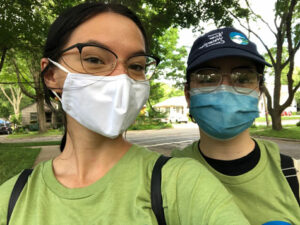A few years ago, when microplastics in our waterways hit the news, HRWC gave away 400 Cora Balls, which are laundry devices designed to catch microplastic fibers in washing machines. It was clear that our community was interested in learning more about keeping microplastics out of the Huron River. However, we did not know what specific actions people would be most interested in trying and if those actions were durable.

Upon investigation, we did not see any behavior change studies around the country regarding actions that people can take to ‘catch the plastic’ in laundry rooms. Thankfully, HRWC received a behavior change research grant from the Erb Family Foundation, allowing us to research which actions people are most likely to take to reduce or capture plastic microfibers in the laundry cycle, and what barriers might prevent them from taking action. HRWC provided participants from two neighborhoods with tools that removed barriers to specific actions. HRWC is using this research to determine how plausible these actions are on a wider scale, and we will design messaging based on participants’ feedback.
Choosing actions, making them easy to adopt
There are many sources of microplastic pollution. The U.S. Geological Survey did a study in 2015 of the Great Lakes, which included the Huron River, and found that the number one source of microplastic pollution comes from microfibers. By addressing plastic fibers for our behavior change project, we focused on the biggest component of microplastic pollution in our watershed.
There are several ways we can all reduce microplastic fibers from entering our waterways. For this project, we interviewed program staff at other organizations and conducted four virtual focus groups in October of 2020 to find out which actions participants were most likely to take. We found that most were drawn to using Cora Balls, installing filters on their washing machines, and buying clothing made with natural fibers.
Working with Action Research, a leading community-based social marketing consulting group, we selected 708 households from two neighborhoods in Ann Arbor and went door to door to find out if the neighbors were interested in getting a free Cora Ball, a Shopper’s Guide to buying clothes made with natural fibers, and/or a free washing machine filter with installation. Overall, the 174 households that responded to the survey were interested in the microplastic fiber issue and what they could do to reduce their impact. Of those, 147 requested a Cora Ball, 76 stated they would be interested in a filter if it were free or at low cost, and an additional 45 stated they would be interested in a filter only if it were free. To make it easy for households to take action, we delivered the Cora Balls, had 22 Filtrol filters installed by a professional contractor (at no cost to the household), and gave 160 Shopper’s Guides to the neighbors who expressed interest.
Feedback and results
Last November and December we surveyed those who received the Cora Balls, Shopper’s Guides, and filters to find out if they found them useful; if they were, or were not, easy to use; and if they shared information about the tools with others, such as friends and family. Most of the Cora Ball recipients are using the devices, and more than half are seeing debris collected from the wash cycles. Seventy five percent say they are easy to use, and more than half talked to friends and family about it, with 75% of them recommending the product. On a scale of one to ten, the Shopper’s Guide received a 7.2 rating for usefulness among Cora Ball recipients, and a lower rating from filter recipients because they already knew the information, already purchase natural fibers, or will continue to purchase synthetics such as fleece and athletic wear. Those who got filters had incredibly positive feedback. They said the filters are easy to use, they saw results after just a few washes, and many have recommended the filters to friends and family.
Next steps
The behavior change grant provided valuable funding for community-based social market research that is uncommon among smaller nonprofits like HRWC. By investing time and resources in behavior research at a community level, our outreach can lead to more actions that protect the watershed and each other.
This project taught us valuable lessons. Residents stated they believed a lot of people would be interested in using a Cora Ball or installing a washing machine filter. They also recognize that many people are not aware that microplastics are a problem and that there are simple actions that can help. We need to keep educating people about microplastic pollution in our waterways. Providing laundry devices to households exposed participants to straightforward, effective solutions, and most participants were willing to share this information with others—which is key for these solutions to catch-on at a broader scale.
We now have strong recommendations for specific ways to get the word out about how to reduce microplastic pollution from synthetic fibers using the tools we tested. Click on the links to check out the report and learn more about how you can catch the plastic.
—Anita Daley
This blog post was originally published March 1st in the Huron River Report, Spring 2022.



